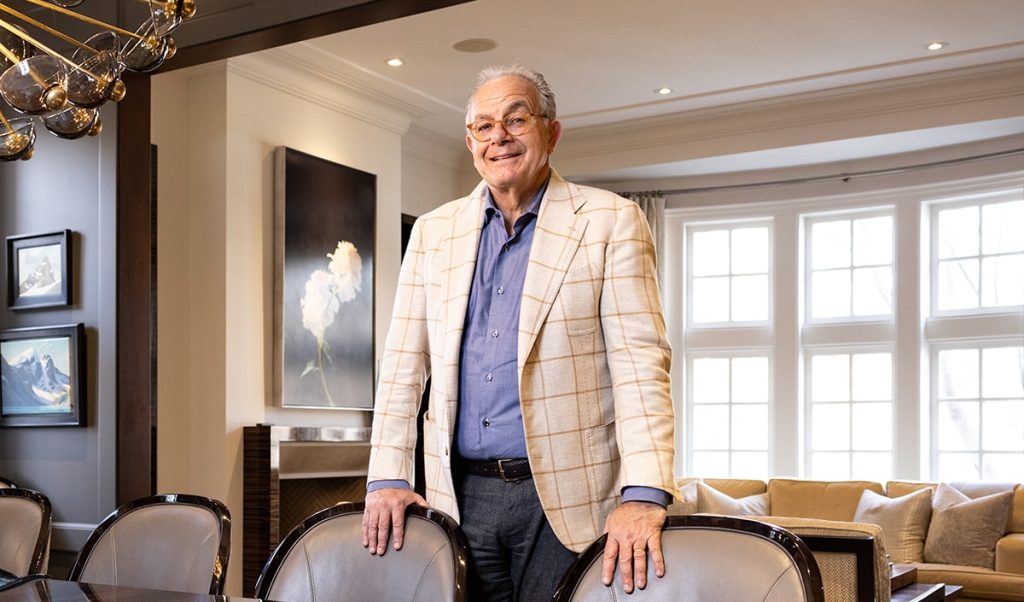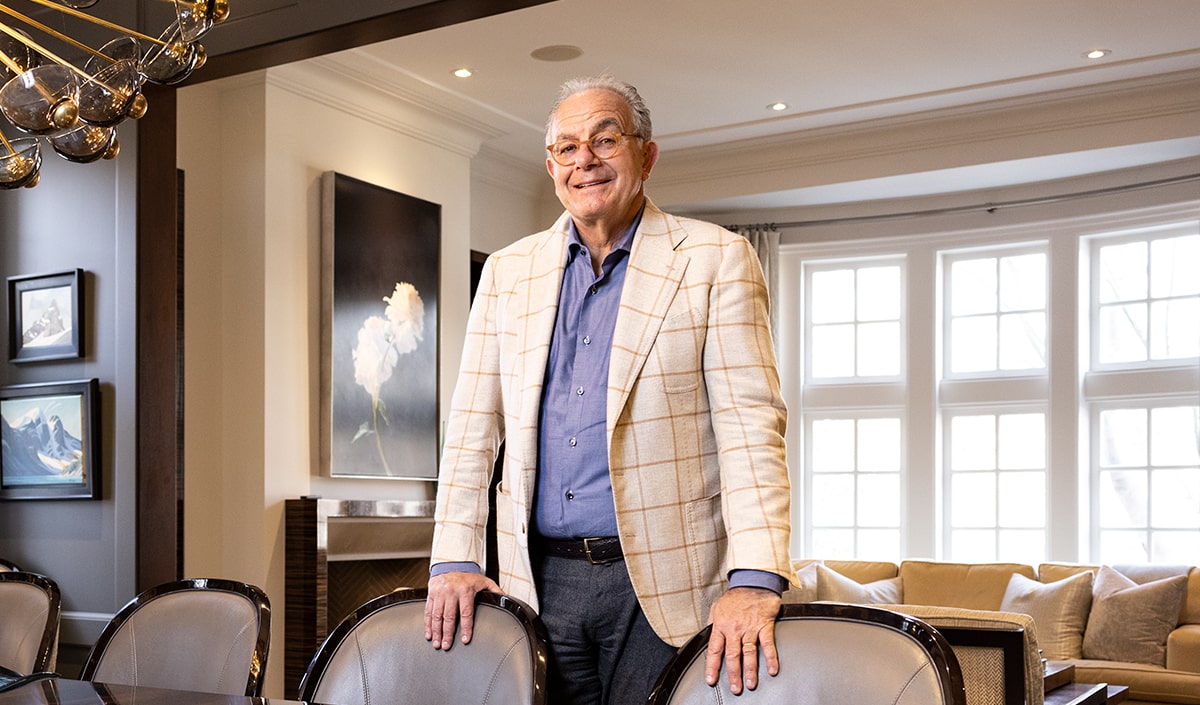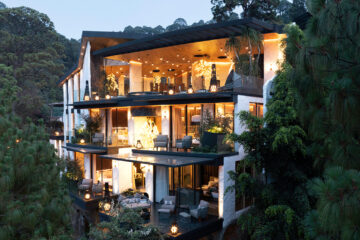Richard Wengle: Emotion By Design
Architect Richard Wengle’s luxury home designs create excitement, warmth and emotion.
A blessing in life for a fortunate few is knowing how you want to spend it, at an early age. For the vast majority, we stumble through our awkward teenage years without a clue, searching for the spark of interest that could launch us on a satisfying career path.
One of those fortunate few, for whom the career spark came early and bright, is Richard Wengle, now one of North America’s most respected and admired designers and architects of custom-designed luxury homes and residences.
“My interest in architecture started in high school,” says Wengle in a recent interview with Dolce. “I always loved construction and design and drawing as a kid and was always building things and by Grade 11 I was 100 per cent sure that’s what I wanted to pursue.”
Following graduation from architectural school in 1983, Wengle spent his first years at the same company before starting his own firm in 1992 to, in his words, “pursue my own ideas” and unlock the emotion and passion he possesses for good architecture.
“Good architecture will touch emotion first,” observes Wengle. “It could be subliminal, but someone can look at something and it will create a feeling of excitement, curiosity, warmth and, almost, sometimes, exuberance because it might remind you of something, and that plays on your emotions. The wonder of space and light is incredible, but it is also tied to experiences and an emotional attachment to things in order to appreciate them. Part of being an architect is the appreciation for the built form.”
He began to build his reputation with custom-designed single-family luxury homes and he has kept his Toronto-based Richard Wengle Architects Inc. intentionally small, with a staff of fewer than 20 professional designers and architects, so he could meet all his clients and get to know their dreams and aspirations for their homes.
“I’m involved with every project from the beginning, so it is our vision and it’s consistent,” says Wengle in explaining his firm’s process. “For me, it’s all about connecting with our clients and maintaining a relationship with them, and after the project is completed, we remain friends. Some clients know exactly what they want, while others depend upon us to guide them. We have a broad range of architectural styles on purpose, and it’s nice to be able to speak in many dialects of the architectural language.”
Wengle describes his firm’s signature as “detail, proportion and style” in creating bespoke residences with tailored elegance of the highest quality. “Pragmatic design is important, so the house has to function well,” he says. “There is no point in designing something beautiful that doesn’t work. The flow and functionality of the home are very important, then you can get into the elegance and the special moments of a home, which become creative. The house should be designed so that it caters to those large events you may host, but also when you are there quietly, as your home is your sanctuary.”
Just over a decade ago, developers of luxury boutique condominiums in the Greater Toronto Area began to notice what Wengle was doing, his many different styles, his thoughtfulness in design of the highest calling and, perhaps most importantly, in a vertical city of glass-box towers, how his projects met the streetscape.
We care most about architecture where we interact with it, and, for most of us, that is at street level. Do we really care that a building may soar 40, 50 or 60 storeys above us? Probably not. But we do care about architecture when we can see it right in front of us, as impactful design is a major part of the look and feel of our community surroundings.
“Developers wanted to bring the designs of their condominiums up a notch, and we started with a building in Oakville, Ont., and that was a major turning point for us,” says Wengle. “We’re doing about eight or nine more currently and we are getting approached all the time to build more unique, boutique-style buildings. Developers tell us they see in our designs our abilities to really relate to the streetscape, have a lot more character and more of an everlasting presence in order to bring their buildings to the next level.”
Richard Wengle Architects is designing projects in some of Toronto’s most desirable neighbourhoods, including the exclusive midtown enclaves of Forest Hill and Yorkville, where construction has started on 89 Avenue Road by Armour Heights Developments, a 20-storey luxury boutique condominium reminiscent of the Central Park area of New York.
“The 89 Avenue Road condominium is pre-war style, and we’re doing 77 Clarendon for Menkes Developments and we just finished One Forest Hill by North Drive,” says Wengle. “So, there are a lot of beautiful buildings, and we’re sort of leaving Toronto in a better place than we found it, hopefully. The goal with each project is that we want to raise the bar and bring ideas that we have to our new projects.”
Architects notice things the rest of us do not, and as an avid word traveller who lived in Venice for six months as a student, Wengle receives much of his inspiration from historical sites and buildings.
“My inspiration comes from tactile surfaces or things like that,” he says. “I’m known to look at a stone wall somewhere and take many pictures of it, as I just get excited by the historical details and employ some of that in our buildings. I also learn about the interpretation of materials that are different than what we haven’t used here in a long time and new ways to employ them. A lot of architecture you see is just glass and metal panels and there is no life to them — they are just there to fill space. When you look at a building that is well-built and well-crafted and you see all the details that have been put into it, for an architect, that’s what you dream about. Probably only an architect can appreciate what a builder can provide.”
“There is No point in Designing Something Beautiful that Doesn’t work. The flow and Functionality Of the home is Very important”
The firm has become known internationally, designing homes in the United States, Croatia and the Bahamas and recently designed a home in Stockholm for former National Hockey League star and former captain of the Toronto Maple Leafs, Mats Sundin, which Wengle termed one of the highlights of his career. Despite this international recognition, Richard Wengle likes his position in the centre of the architectural field in Toronto, where he continues to see the city punching above its weight when it comes to design that is world-class.
“What is really great about living in Toronto is, we’re not locked into one particular esthetic here,” he observes. “We have so many different architectural styles open to us, more than probably any city in North America. In Toronto, there is a huge array of modernism, contemporary and traditional work, and even within the traditional, there are many variations on this theme. It is truly really an incredible city and it is one of the best cities to be in. And I am proud to be able to contribute to it.”
For someone who is so in tune with how and where we live, Wengle has some interesting and insightful thoughts on the importance of home, especially considering what we have all experienced these past two-plus years.
“What I have learned about society these past two years is that home is a lot more important to people than they ever thought,” says Wengle. “It wasn’t just a place to come home to, especially when you’re living in it all day, every day. It’s a sanctuary, it’s an office, it’s a place to raise your kids, but it’s also a place for a respite, so it has to have that soothing quality that you have a place to escape to in order to relax. I know a lot of people who have enjoyed being at home, and I’m one of them, as long as you have the tools and the space, and we’re seeing a lot of that now because of COVID.”
Architecture is one of those fields we all have opinions about, similar to art or music. We may think something is bold and new, but it takes the keen eye of a professional to reveal that what may appear to be a new trend has visited us many times before. “Architecture is like the ballet or the symphony, as people still go to see and hear both of those art forms, and they are hundreds of years old,” says Wengle. “Architecture is still progressive because styles have repeated themselves over the years as things of influences. You see a lot of modernism, but that is influenced from the 1940s and 1950s. Look at art deco architecture, that was 80 years ago. Styles cycle and they repeat themselves, but they have new interpretations of them, as they are all still influencers.”
From a 16-year-old kid who knew exactly what he wanted to do to an internationally respected architect doing exactly what he loves, Richard Wengle has brought his emotion and passion to his craft — for the benefit of his community.
Interview by Estelle Zentil


















































































